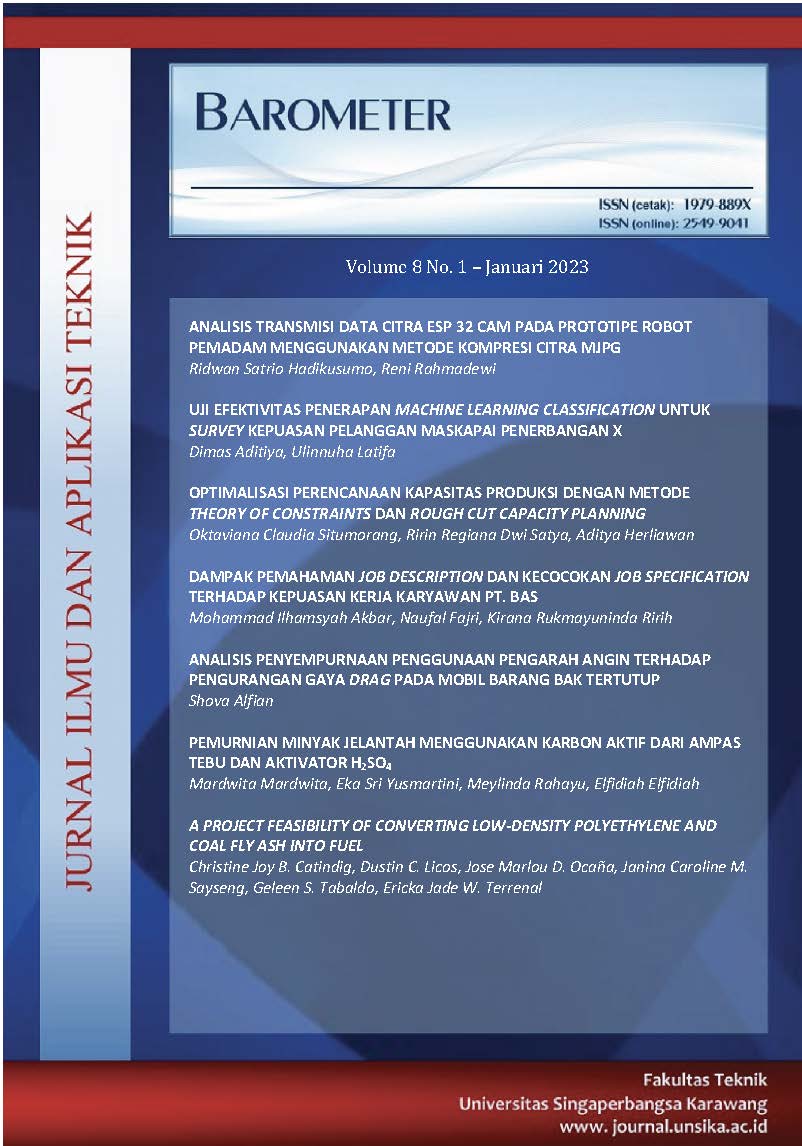OPTIMIZATION OF PRODUCTION CAPACITY PLANNING WITH THE THEORY OF CONSTRAINTS AND ROUGH-CUT CAPACITY PLANNING METODHS
DOI:
https://doi.org/10.35261/barometer.v8i1.6826Abstract
PT. MTI has a problem that often occurs in planning its production capacity, where there are often delays in the delivery of ordered products. One of the causes is also the inhibition of the production process at one of the workstations, resulting in the flow of the production process. Theory Of Constraints (TOC) is an improvement method that helps in making decisions in managing resources. The TOC method is also very useful for optimizing production capacity by analyzing and minimizing time constraints that support production. In addition, the Rough Cut Capacity Planning (RCCP) method is a method for calculating capacity requirements and comparing them with the available capacity. The data used in this study are product demand data, product processing time, product structure, and working hours. From the results of data processing with the TOC approach, it was found that the workstation experiencing obstacles was the welding workstation and the amount of buffering at the workstation was 5.22 hours before the workstation and 4.97 hours after the obstacle station. And the results of data processing with RCCP and LINDO software get the optimal production capacity produced by PT. MTI is 181 units per month with the distribution of 101 units for Pallet 1A, and 80 units for Pallet 3A, and based on the largest MPS comparison, it is stated that the company's capacity is not sufficient to meet the largest demand for MPS in November. So the company needs to increase the working hours overtime or by adding several units of machines to the workstation constrained by the welding station.
Downloads
References
T. P. Adhiana, I. Prakoso, dan N. Pangestika, “Evaluasi Kapasitas Produksi Ban Menggunakan Metode RCCP Dengan Pendekatan Bola,” J. Rekayasa Sist. Ind., vol. 6, no. 1, hal. 11–17, 2020.
D. Rahmawati, P. Puryani, dan E. Nursubiyantoro, “Optimalisasi Kapasitas Stasiun Kerja Dengan Penerapan Theory of Constraints (Toc),” Opsi, vol. 12, no. 1, hal. 12, 2019, doi: 10.31315/opsi.v12i1.2828.
I. Siregar, “Application of Theory of Constraints in Bottleneck Work Stations Optimization,” J. Phys. Conf. Ser., vol. 1339, hal. 1–4, 2019, doi: 10.1088/1742-6596/1339/1/012024.
Z. T. Şimşit, N. S. Günay, dan Ö. Vayvay, “Theory of Constraints: A Literature Review,” Procedia - Soc. Behav. Sci., vol. 150, no. 231, hal. 930–936, 2014, doi: 10.1016/j.sbspro.2014.09.104.
Z. F. Hunusalela, “Usulan Penjadwalan Produksi Dengan Menggunakan Theory of Constraint Pada Bagian Welding Rear Body PT Krama Yudha Ratu Motor,” Fakt. Exacta, vol. 6, no. 1, hal. 70–86, 2013.
M. Zakaria, Syukriah, dan R. A. Selvia, “Metode Rough Cut Capacity Planning Di Pt Wijaya Karya Beton,” Ind. Eng. J., vol. 10, no. 1, 2021.
D. D. Saputra, “Usulan Penerapan Theory of constraints Guna Mengoptimalkan Kapasitas Produksi Pada PT XYZ,” Sci. J. Ind. Eng., vol. 1, no. 2, hal. 7–11, 2020.
V. Gazperz, Production Planning and Inventory Control. Jakarta: PT SUN, 20M.
N. O. Umesh Nagarkatte, Theory of Constraints : Creative Problem Solving. Boca Raton: Taylor & Francis Group, 2018.
A. Y. Nasution, S. Yulianto, dan N. Ikhsan, “Implementasi Metode Quality Control Circle untuk Peningkatan Kapasitas Produksi Propeller Shaft di PT XYZ,” J. Mesin Teknol., vol. 12, no. 1, hal. 33–39, 2018.
R. Zulmaulida dan E. Saputra, “Pengembangan Bahan Ajar Program Linear Berbantuan Lindo Software,” Infin. J., vol. 3, no. 2, hal. 189, 2014, doi: 10.22460/infinity.v3i2.63.
C. Erliana, Analisa dan Pengukuran Waktu Kerja. Aceh: Fakultas Teknik Malikussaleh, 2015.
R. A. Maulana, D. Herwanto, dan K. Kusnadi, “Analisis Perencanaan Persediaan Suku Cadang dengan Metode ABC dan Metode Min-Max di Bagian Fields Service Engineer PT. Merck Chemicals and Life Science,” Barometer, vol. 6, no. 1, hal. 295–300, 2021, doi: 10.35261/barometer.v6i1.4480.








